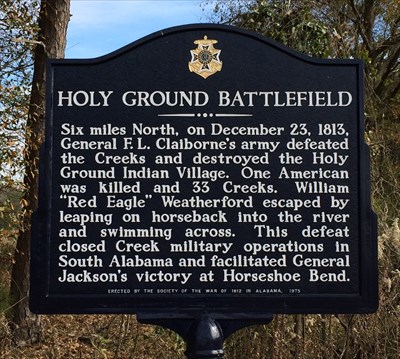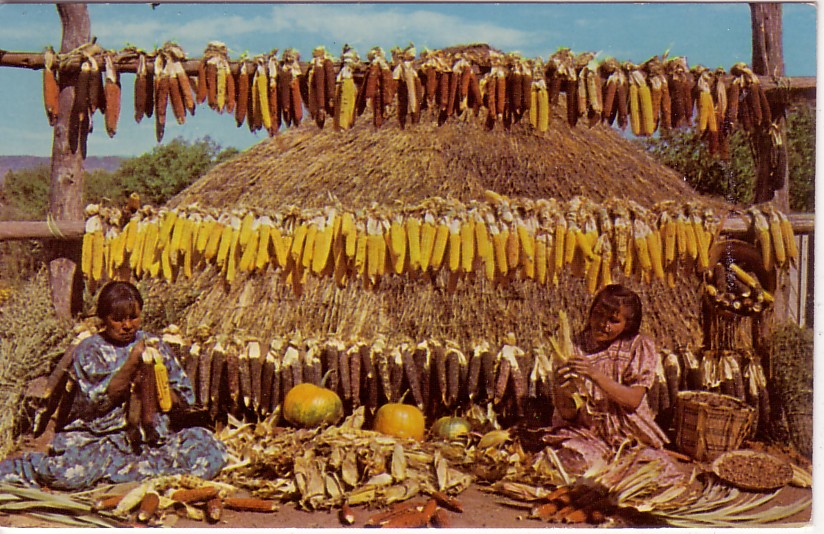The Battle Of Holy Ground Was A Very Short One
The Battle of Holy Ground was the campaign and engagement between the Creeks and the Whites in South Alabama, which lasted for several weeks and ended with this famous battle on December 23, 1813.
It took place in what is today, Lowndes County, at a site referred to as Econochaca, which was a fortified encampment established in the summer of 1813 by Josiah Francis.
It was fought on a bluff above the Alabama River and was one of three encampments that had been erected by the Red Stick Creeks during the summer.
The term “Holy Ground” was formed by the Creeks from the name “Econochaca”, which means to create a spiritual barrier of protection.
Properly translated, it means sacred or beloved ground.
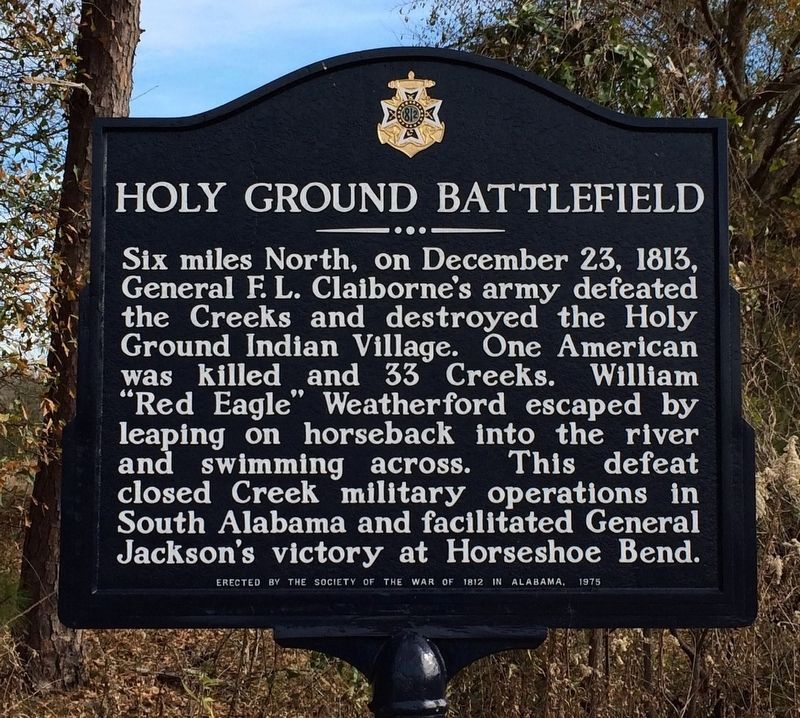 Holy Ground Battlefield Sign
Holy Ground Battlefield SignThe History of the Battle of Holy Ground
The History of the Battle of Holy Ground starts with the Battle of Burnt Corn, which was followed by the Fort Mims massacre.
General Ferdinand Claiborne, who was under the orders of General Thomas Flournoy, started to round up troops to attack the Red Stick Creeks, and by early December, he had a force of over 1,000 men.
These men included not only whites, but 150 Choctaw warriors, who were bitter enemies with the Red Stick Creeks.
Holy Ground was the Indian town of controlling influence among the Indians, during the Creek Indian war of 1813-1814.
Located about two miles north of White Hall, Alabama, the town contained the council house of the Alabama tribe and was also the residence of the principal Creek prophets.
These prophets, with their magic spells, once the opening of the war started, asserted to their people that the site had been made holy and protected against the intrusion of the whites.
Before the Battle of Holy Ground, this site had also been their main base for their provisions as well as war supplies, in all of the operations against the white settlers.
The site where this battle took place is now the home to the Holy Ground Battlefield Park, and is fully maintained by the United States Army Corp of Engineers.
It was officially added to the Alabama Register of Landmarks and Heritage on May 26, 1976.
The Battle of Holy Ground and the Creeks Precautionary Steps
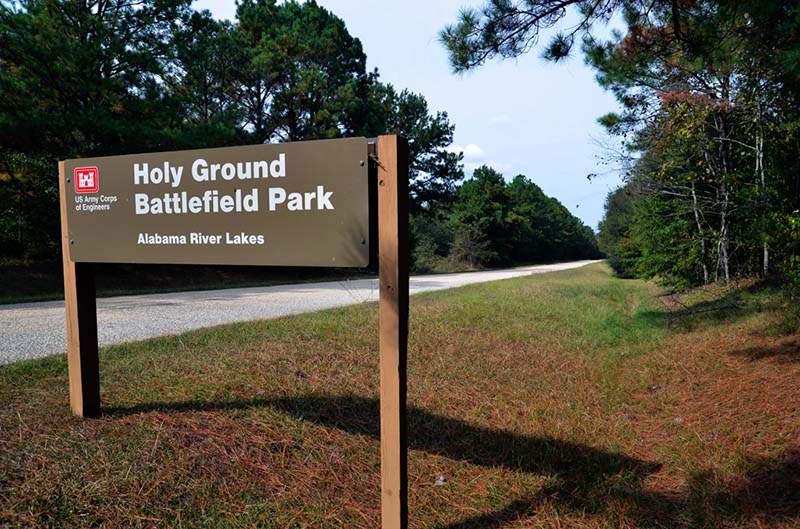 Holy Ground Battlefield State Park
Holy Ground Battlefield State ParkThe Battle of Holy Ground was taken very seriously by the Red Stick Creeks, who took several steps to protect their people.
When General F. L. Claiborne, who was in South Alabama, made the decision that this site must be destroyed, marched his army form the Tombigbee to Weatherford’s Buff on the Alabama River, in November of 1813.
Once there, he established a depot of numerous provisions, for General Jackson to build a fort, which was named Fort Claiborne.
On November 28, his regular army was reinforced by the 3rd United States Regiment, which was under the command of Col. Gilbert Christian Russell.
On December 13, General Claiborne moved his troops from the fort toward the “Holy Ground”.
After several days of marching, they made a brief halt in what is today, Butler County, where a depot was established that became known as Fort Deposit.
There he left several wagons, cannons, baggage and the people that were sick, and left 100 men to guard them.
He then resumed his march toward his target.
The Red Stick Creeks, who soon learned about his approach, begin to take the precautionary steps.
They moved their women and children across the Alabama River, into what is today, Autauga County.
By making this move, they demonstrated that they did not have a lot of faith in their prophets, that this ground was indeed protected.
On December 23 their town was attacked, and the actual battle only lasted about one hour, and resulted in complete defeat of the Red Stick Creeks.
The exact tolls are not fully known, but it was estimated that 33 Indians were killed, and the whites only suffered one death and 20 injuries.
The shortness of the battle was due to the scarcity of ammunition that Creeks had, who had to rely on bows and arrows to fight the U.S. Military.
The Spoils of the Battle of Holy Ground
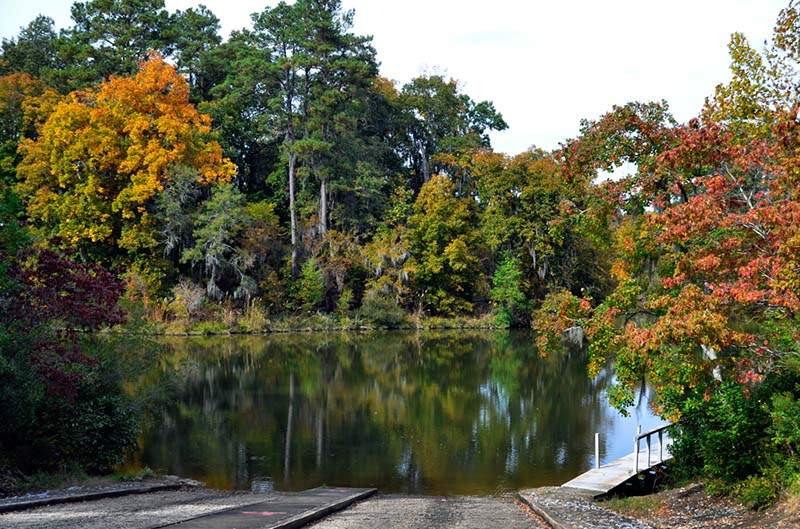 The Battle Of Holy Ground
The Battle Of Holy GroundThe spoils of the Battle of Holy Ground were given by General Claiborne to the Choctaw allies, for their support and bravery during the battle.
He then burned the town down, and for two days he spent all of his time in totally destroying any and all towns that were anywhere near the site.
Included in this destruction where the Indian farms, as well as all of their canoes and boats.
This major defeat ended the military operations in the South Alabama area and helped lead to the final and decisive battle of Horseshoe Bend.
After this battle was completed, the Army returned back to Fort Claiborne, where the vast majority of the volunteers were honorably discharged as the terms of their service had expired.
References
https://www.exploresouthernhistory.com/holyground1.html
The Military History Of Alabama

Alabama Gift Store
Numerous Items for You and Your Family to Enjoy
See it here at the Gift Store
Copyright 2019-2023 Alabamabackroads.com
All Rights Reserved
